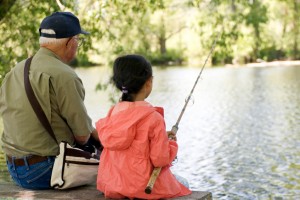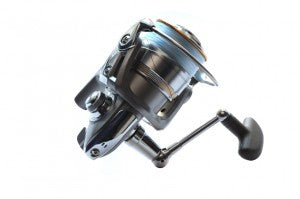
Get a Fishing License
In order to fish, you’ll need a state-issued fishing license. Each state has rules and regulations for fishing that you’ll want to be aware of. Fishing licenses are easier to obtain than you might think. You can purchase one from a local sporting goods store (I went to Dick’s Sporting Goods) or even from a Walmart with a sporting section. You’ll have the option to buy a one-day pass, week pass, or year pass. I found that if you’re serious about practicing fishing as a survival skill, the year pass is actually less expensive in the long run and seems to be a better deal, even if you don’t plan on fishing all the time. You can even purchase a fishing license on your state’s Division of Wildlife Resources website. For other locations, check out TakeMeFishing.org to Replace out how/where you can get one. Some states even offer free fishing days where you don’t need a license. Check out this chart to Replace out when the free fishing days are in your state.Supplies You’ll Need
Word of Caution:
If you buy a rod that includes fishing line, the line may not be durable. It may tangle easily, get knots, and may make casting your line and reeling in your fish difficult. Store in your tackle box.
Fishing Rod
You can purchase fishing rods that already come equipped with a reel and line. As far as rods go, you want to make sure your rod is flexible, but also durable. According to Fishing League Worldwide, if you’re a beginner, you’ll want to have a “5-5 1/2 foot, two-piece [a rod that can be broken down into two pieces] . . . that’s easy to cast and transport, and will cast light lures.” A light lure is one that won’t have a lot of fancy features on it (feathers, weights, etc.) and won’t weigh down the line (see the section below to learn what a lure is).
Reel
If you’re a beginner, I’ve personally found that a spinning reel (see the picture below) is easiest to handle for adults (spincasters with push buttons are easier for children to use). Spinning reels come with a locking mechanism that you simply flip up and down to close and release your line (see the thin silver half circle on the right side of the picture? That’s the locking mechanism. In the picture, the reel is locked.)

Picking your Fishing Line
Rick Tilson, a champion angler, describes each of the different types of lines and what they work best for. If you’re looking for more of a challenge or found that monofilament lines don’t work for you, check out Rick’s informative article. Once you get to know the fish in your lake and talk to more experienced anglers there, you’ll start to learn what type of line works best. You can also visit a local angler website to Replace out. For more tips on selecting your line, check out noted angler, Babe Winkleman’s article, “Choosing the Right Fishing Line Is and Isn’t Easy.” Sportsmansguide.com and Fishing League Worldwide both suggest that getting a 10-12 pound monofilament line is a good place to start if you want to catch larger fish in a larger body of water. Beginners, however, will probably want to start in a smaller body of water (think lakes or creeks). If you’re fishing in a lake or creek, you’ll want to use a lighter line, like a 2-6 pound monofilament, because fish in natural environments are typically smaller than fish in reservoirs that are stocked regularly with fish. What do I mean by Stocked? Usually, in state run parks, park authorities will stock the lake with fish. This means those fish were not born in that lake, but were brought there later on. Since these fish were raised in a more "controlled" environment, they were probably getting fed pretty well--hence, they'd be bigger than fish that had to fend for themselves in the wild.Stringing Your Fishing Pole
When you get a pole with fishing line included on it, you’ll still have to “thread” the line through each of the “eyelets” on your pole. Make sure you’ve unlocked your reel so that you can have enough line to pull through the loops and still have enough to fish with. If you don’t have a fishing pole with the line already attached, or you want to change out the line on the reel, check out this video on how to put the line onto your reel.Bait and Lures
Learn about the fish and what type of bait and lures they respond to before you go out on the location (I learned this the hard way.) Talk to other anglers. You may want to visit the lake you’re thinking of fishing at and ask the people who are catching fish what they use. But first, check your state wildlife laws. Some areas do not allow live bait. Fish LOVE live bait—worms, crickets, maggots, and grasshoppers. It’s a good idea to take a variety of baits with you, both live and non-live bait (Powerbait, salmon eggs, etc.). This way you can test out what works best. Unlike bait, lures are not alive.They’re either a piece of decorative metal or plastic that you can use to attract fish. Using a lure is a cleaner way to fish. When I caught my first fish, I only used bait so when I pulled my fish in, it was gut hooked (the hook went in too deeply and removing it was tragic for both me and the fish . . .). Lures are a little more expensive than live bait. They can also cover more water than bait can; it’s easier to lose your bait than a lure if you are moving your line around to attract fish. However, this doesn’t mean that it’s not easy to lose a lure, too. There are seven main types of lures:- Jigs (good for ice fishing)
- Spinners
- Spoons
- Soft plastic baits (think gummy worms)
- Plugs
- Spinnerbaits
- Flies
Quick Tip: Bring a cooler full of ice so you can keep your fish fresh (after you gut them) or fresh until you get home, so you can gut them there and store them in your freezer.

8 comments
Zachary Tomlinson
Thank you for this extensive guide regarding beginner fishing gear! My brother has been thinking of starting fishing as a hobby and I believe that he needs the right equipment first before he can fish properly. I find it interesting to learn that you can start with an inexpensive reel before buying more expensive ones. I believe that you can upgrade every single one of these here incrementally. https://www.wilcoxbaitandtackle.com/tackle
Jenna Hunter
I really liked what you said about picking your fishing line. This would be really helpful for my sister who wants to learn how to fish. It would be great if she had a good spot to fish. https://milwaukeeoffshorefishing.com/milwaukee-fishing
Jay Williams Smith
This info is great, but if you want to know more about fishing lure types follow the link http://akfishinglures.com/
sarrah
Always take a firearm or some form of self-defense with you! This is not Norman Rockwell’s America any longer.
beprepared
Peter,
Thanks for the tip for those living in Utah county.
Peter
For those interested Orem City and DWR do fishing class in the spring for ages up to 12 years old . Check with the Orem rec center for more info
Kelli McManus
Excellant article ! If i was a beginner angler i would find this information helpful. When I did start fishing I had to learn some of it on accident ;-)
randy
When releasing fish too small to keep back into the water, always be sure to dip your hand in water before you handle the fish. Your dry hand can remove mucus (slime) that is on the fishe’s skin to protect it from parasites.